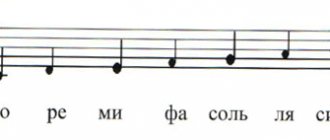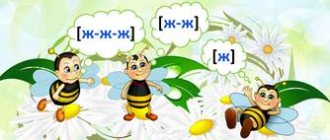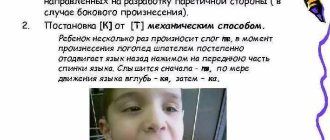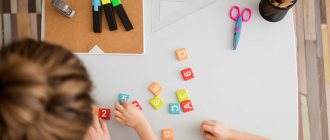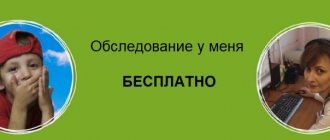Purpose of the lesson: we study the letter Z, the formation of reading skills, the development of speech skills, the improvement of phonemic awareness, the basics of elementary graphic skills.
Tasks:
- introduce the preschooler to the letter Z and the correct pronunciation of the sound;
- teach how to write the printed letter Z in squares;
- to generate interest in learning poems and riddles.
Name what is shown in the pictures below:
Neuschwanstein Castle)
Lock
Hare
Umbrella
- Tell me, how does a mosquito sing? (Z-z-z...)
- What sound is there in both the word UMBRELLA and the word CASTLE, GOAT?
- At the beginning, at the end or in the middle is the sound [z] in the word UMBRELLA? - LOCK? - GOAT? - ROSE?
When we pronounce the sound [z], the tip of the tongue is behind the lower teeth, and the teeth are almost clenched, with only a narrow slit between them. Repeat: ZZZ. Teeth prevent air from freely leaving the mouth when we pronounce the sound [z].
- Vowel or consonant sound [z]?
- Is this sound voiced or dull?
- Why?
- What other voiced consonant sounds do you know?
- What voiceless consonant sounds do you know?
Assignment: printed letter Z for preschoolers
Examine the letter Z. Sew the letter Z in the air and once in the notebook, carefully in the cells with a simple pencil or ballpoint pen.
In cases where the child is asked to write a whole line of a letter, syllable or word, the adult gives a writing sample at the beginning of the line. If a preschooler has difficulties, then an adult can draw two approximate lines, or put reference points that the child will connect with lines, or write the entire letters, and the child will simply circle them in a different color. Calligraphy should not be required at this stage of training.
Print
Lesson summary “Consonants [z], [z'], letter Z. ABC of health”
- - Absolutely right. I propose to characterize the sounds denoting the letter Z. Dress up the sound player. One person comes out and dresses up.
- — While Vasya is working, I offer you this task. In your ABC book on page 49 there are coloring pictures. Color the objects that have the letter Z in their names.
- So, what objects did you paint? Carnation, goat, vase.
- Let's check how Vasya dressed up the sound artist.
- The letter Z can give two sounds - sounds [z], [z']. Sound [z] – consonant, sonorous, hard. The sound [z'] is consonant, sonorous, soft. Therefore, the sound player has a bell on his head, indicating the sonority of the consonant, and on his feet a green shoe - softness, a blue shoe - hardness.
- Tell me the words where the hard sound [z] occurs.
Name the words.
- Tell me the words where the soft sound [z'] occurs.
Name the words.
— I suggest you work in pairs and perform a sound analysis of words. On your table are envelopes with squares representing sounds. The first row will work with the word “vase”, the second - with the word “winter”.
Examination.
- Very good. Now I suggest you play the game “Catch the Sound”. I will name the words, and if you hear the sounds [z], [z'] in the word, you should clap your hands. Health, sports, physical education, porridge, vegetables, exercise, hardening, fruit.
— Tell me, please, what unites all these words?
— They relate to the concept of “health”.
— Tell me, guys, what needs to be done to be healthy? Look at the board and guess the rebus.
FOR + '
— 1. The word “hardening”. You need to harden your body.
- What does it mean?
- This means you need to douse yourself with cold water, not wrap yourself in too warm clothes, and sleep in a cool room.
Physical education minute. Temper yourself like steel.
— What else do you need to do to be healthy?
— 2. You need to play sports.
- Yes, guys. But even if you are not athletes, you should at least do exercises in the morning and move a lot. What sound does the word “charging” begin with?
- With a hard sound [z].
— Read the short text on page 49. What does the text say?
— To keep your health in order, you need to exercise.
— What else makes a person healthy?
— 3. Proper nutrition. Food must be balanced. You need to eat cereals, dairy products, vegetables and fruits, lean meat and fish.
—Where should we start our day?
- Since breakfast. For breakfast, it is best to eat porridge or omelet and drink unsweetened tea. Then the person will receive a charge of vigor and good mood.
— What sound does the word “breakfast” begin with?
- With a hard sound [z].
- And to determine the next component of health, let's read text No. 2 on page 49. Read this text with “buzz reading”. What are we talking about here?
— 4. We must be safe. Follow traffic rules and safe behavior at home: do not climb fences, be careful with piercing and cutting objects.
- That's right, well done. Find words in the text that contain the letter z, underline this letter.
- What else do you need to do to be healthy?
— 5. Observe the rules of hygiene, that is, keep your body clean. Wash your face in the morning, take a bath or shower, brush your teeth.
— The word “teeth” begins with what sound?
- Hard sound [z].
- That's right.
Continue the sentence
He rushes without looking back. Only the heels sparkle. He rushes as fast as he can. The tail is shorter than the ear. Quickly guess who it is? … (Bunny.)
On clear nights, a mother and her daughters walk. She doesn’t repeat to her daughters: “Go to bed, it’s late!” Because the mother is the moon, And the daughters... (stars).
I wake up early in the morning Together with the rosy sun, I make up the crib myself. I quickly do... (exercise).
The forests hide many troubles, there is a wolf, a bear and a fox! Our animal lives in anxiety, running away from trouble. Come on, guess quickly. What is the animal's name? … (Bunny.)
I sit, almost crying, Very difficult... (task).
The roof is covered in fur, White smoke overhead. The yard is covered in snow, the houses are white. At night... (winter) came to us.
There is a clatter of feet in the corridor, which calls everyone to class... (bell).
Tale about the letter Z
Flightless umbrella
A hare was walking in the forest and found an umbrella. Suddenly he sees a wolf looking at him right from the thickets with angry, contemptuous eyes.
“There’s a trap,” the hare shook, “it’s too late to run away.” I’ll stand on a tree stump under an umbrella, maybe the wolf will m-m-mist me for a m-m-mushroom.
So I did. He stands on a stump under an umbrella, his eyes closed, his teeth chattering in fear, but he himself does not move. And the wolf slowly approaches from behind... And then, fortunately for the hare, a strong wind blew! He picked up the umbrella along with the hare and raised it high into the sky. A hare flies over the forest, laughs, bursts into tears, and the wolf below runs along the ground, clicks its teeth, gasps.
- Come on, come on! Press! - the hare screams. - I need to do exercises - I wish I could run faster!
The wolf spat. He sees that he cannot catch up with the hare. He ran to the store, bought an umbrella from the goat, stood on a stump and waited for him to take off like a hare. I stood there until sunset. I was terribly angry!
- Oh, goat! - growls. - I sold the flightless umbrella!
And he tore the entire umbrella with his teeth.
(G. Yudin)
so UNT / Lesson plans for the Russian language / Lesson plans for teaching literacy 1st grade Kazakhstan
Topic: “Sounds [z], [z'] and letters Z z.”
24.09.2014 7062 0
The purpose of the lesson:
introduce children to a new letter, improve the skills of reading two or three syllable words, writing letters, syllables, words with the letter Z.
During the classes
1. Organizational moment
2. Phonetic warm-up
- Let's do a sound warm-up.
— What does the doctor ask you to say when he examines your throat? A-a-a - How does a wolf howl? Oooh - How does a baby cry? Wa-wa-wa - What does grandma say when she's tired? Oh-oh-oh - And when is mom upset? Eh-eh-eh - And when does dad scold? Ay-ay-ay - How does a mosquito ring? Z-z-z 3. Checking what has been learned.
The letters given are: A, O, U, I, K, Y.
- Find the extra one, why? Prove it. Game “Hidden Word”
In each of the words: duck, pillar, prick, bison, scythe, darkness, regiment, fishing rod, wolf, another word is hidden.
What words are these? 4. Report the topic of the lesson.
Today guys we will get acquainted with new letters
Problem situation Guess the riddles.
Guys, listen to the riddles. The grain scattered by night. We looked in the morning and there was nothing. (Stars) - How many vowels are in a word? (2) - How many syllables? (2) - Divide into syllables. - Put emphasis. — Make a sound scheme.
White in winter, gray in summer. Jumps deftly and loves carrots. (Hare) - How many vowels are in a word? (2) - How many syllables? (2) - Divide into syllables. - Put emphasis. — Make a sound diagram 5. Setting a learning task
- I will pronounce the words, listen to them carefully and find the same sound in the words: goat, eyes, rose, hare, umbrella, nest.
(Sound [z]). - Who remembered the words I said? Where is the sound hidden in the word? - Find the same sound in the words: Zina, rubber, mastic. - Have you guessed what sounds we will talk about today in class? (About the sound [z], [z']). - Who knows the name of the letter with which we write these sounds? (Letter “ze”). - Who will tell the topic of our lesson? Characteristics of the sounds [z'] and [z] -
Conclusion. The sounds {З}, {З ´} are consonants. Showing the letters Z and z printed and written. 6. Game exercise in recognizing sounds [з'] and [з] in words:
If you hear the sound z, clap your hands: picture, basket, cardboard, star, fox, castle, zebra.
7. Physical exercise.
Pinocchio stretched, Once, he bent down, Two, he bent down, Three, he bent down, He spread his arms to the side, Apparently he couldn’t find the key.
To get the key, we need to stand on our toes. 8. Working with the Primer.
Examination of the letters in the "Primer" How are they similar and what is the difference?
The name of the letter is z. Consider the blue-green card with the letter z. Why guys is one blue and the other green? What does the letter z look like? Look at this letter, It’s just like the number 3. I wriggle like a snake, You can’t draw me! 9. Reading syllables and words with a new letter.
Read the syllable - name the word with this syllable: Zu - teeth, za - goat, zi - basket, zy - frost, zo - dawn.
Reading words in columns.
Za-ra's tooth Ko-za's umbrella's teeth Gro-za's umbrella bison
Reading words in arrow order:
goat, thunderstorm, fence, castle, scythe, fox, sleigh, kindergarten.
Insert letters into the words and read
: elephant, fox, bison, goat, ostrich.
10. Physical exercise.
The wind is blowing in our faces.
The tree swayed. The wind is quieter, quieter, quieter. The tree is getting higher and higher. 11. Letter.
Work in copybook. Comparison of printed and written letters Zz.
Introduction to Written Letters: Continuous writing of the lowercase letter z. Continuous letter of the capital letter Z. Stroke of the letter, letter according to the model. 12. Summing up the lesson.
-What new did you learn in the lesson? - What was interesting? — What was difficult? Well done! Well done!
Riddles for children starting with the letter Z
I will paint the branches with white paint, I will throw silver on your roof. Warm winds will come in the spring And they will drive me out of the yard. (Winter)
Jumps across the field - hides his ears. He will stand up like a pillar - his ears will stick out. (Hare)
I dusted the paths, decorated the windows, gave joy to the children and took them for a ride on a sled. (Winter)
Even though she herself is snow and ice, And when she leaves, she sheds tears. (Winter)
When everything is covered with gray snow and the sun says goodbye to us early? (Winter)
Rusting, rustling the grass, A living whip crawls through. So he stood up and hissed: Come, those who are very brave. (Snake)
The rope lies, the cheat hisses. It is dangerous to take it - it will bite. Clear? (Snake)
He crawls on the ground, but doesn’t let him come to him. (Snake)
If you roll it up, it’s a wedge; if you unfold it, it’s a damn thing. (Umbrella)
I walk in the rain and in the heat: This is my character. (Umbrella)
Thirty-two thresh, One turns. (Teeth and tongue)
The scythe does not have a den, he does not need a hole. Legs save you from enemies, And bark protects you from hunger. (Hare)
What kind of forest animal Stood up like a column under a pine tree And stands among the grass - Ears larger than head? (Hare)
Long ear. A little ball of fluff, Jumps deftly, Loves carrots. (Hare)
Who loves carrots and jumps smartly. Spoils the garden beds, Runs away without looking back? (Hare)
Not a lamb or a cat. Wears a fur coat all year round. A gray fur coat is for summer, a fur coat for winter is of a different color. (Hare)
Millet is spilled onto a black scarf. The cockerel came, but it’s not easy to peck. (Stars)
White flowers bloom in the evening and fade in the morning. (Stars)
A tired shepherd walked behind a countless flock at night, and when the rooster crowed, the sheep and the shepherd disappeared. (Stars and month)
I’ll go to the warm land, I’ll rise up to the sun, There will be a whole family in it like me! (Corn)
What is visible only at night? (Stars)
Types of incorrect articulation
Violations in the pronunciation of “Z” can be divided into 2 groups:
- expressed in distorted pronunciation of whistling sounds (sigmatism);
- expressed in replacement with other sounds (parasigmatisms).
Types of sigmatism:
- Interdental. The tip of the tongue is located between the teeth. Speech acquires a “lisp.”
- Side. The lateral edge of the tongue is pressed to the right or left to the molars. The tongue rolls to one side.
- Nasal. When speaking, air enters the nasal cavity. Nasal sigmatism occurs in children with cleft palate or palate paralysis.
Types of parasigmatism:
- Prizubny. When pronouncing the sound “Z”, the tongue rests on the closed teeth. Because of this, “Z” is replaced by “D”.
- Hissing. During pronunciation, the lips are strongly rounded and no groove is formed on the tongue. "Z" changes to a soft "F".
- Emollient. The mouth does not open enough, the teeth do not come apart from each other. The result is a sound that is softer than required.
- Replacements due to deafness. The lips are drawn out into a long tube, the tongue does not rest on the teeth, and there is no sonorous sound.
If defects in sound pronunciation are not corrected, then during school years the child will develop illiterate oral and written speech and will have problems with reading and understanding what is read.
In addition, problems with sound pronunciation can arise as a result of damage to the speech parts of the brain.
If a child has a correctly formed articulatory apparatus, but the sound is still not produced, it is worth seeking advice from a neuropsychologist. He will conduct a diagnosis and draw up a correction plan.
Funny poems about the letter Z for children
Today’s breakfast “Tomorrow,” I thought yesterday, “I’ll sit down to breakfast in the morning. Breakfast is here, but where is tomorrow? I sat down to breakfast today. (V. Berestov)
Bunny, bunny friend! Sit with me for an hour. - I can’t do it for a minute - I’m running to visit the hedgehog. He met me yesterday. He invited me to eat cloudberries. (F. Bobylev)
It’s cold for the bunny in the forest - Let’s knit socks for the gray one. (A. Pudval)
Bunny A bunny is riding on a tram, A bunny is riding, reasoning: “If I bought a ticket, Who am I: a hare or not.” (A. Shibaev)
Why did the bunnies take the green umbrella from the little housewife? Then, to hide from the wolf, Under this silk umbrella. (G. Satir)
The hare says to the hare: “I wish I had a ravenous appetite!” - Appetite is of little use, I wish I had teeth like a wolf. (V. Viktorov)
The snake charmer is busy with his sonorous music. And to the music, friends, the snake will dance too. (V. Berestov)
Rubber Zina Bought in a store, Rubber Zina brought in a basket. She was gaping. Rubber Zina, Fell from the basket - Smeared in mud. (A. Barto)
The sun rises early and hurries to the garden: - Are the vegetables all right? How are things going in your garden? Are you feeling drowsy? Reluctant to move? I command everyone: get up! We'll do physical exercises. Come on, do the following exercise with me: Up, down, Stretch, Wake up completely. Shake off your nighttime laziness - The work day is ahead. We need to have time for the tomatoes to turn red by the evening. The eggplants will turn blue, the melon and pumpkin will turn yellow. We need to be in time for dinner. (T. Polyakova)
Zebu knows neither snow nor blizzard. He was both born and raised in the south. I’m used to palm trees and the southern sky. Although he is just a bull... (B. Zakhoder)
Strawberry Strawberry Near the tree stump she said to everyone: “I’m not there!” - She looked around and then hid under a leaf. The sun's ray found her. He shouted: “It’s not good!” I deceived you! Ah ah ah! Strawberry, get out! - The berry blushed and said: - Sneaky... (L. Fadeeva)
Would you like to know why the Little Robin got wet early in the frozen thickets? Would you like to know why, Looking into the zenith, the finch rings loudly and cheerfully? Would you like to know why the snake rustled? I would like to know why the earth is turning green? (V. Lunin)
They want to give me a puppy for my birthday, but I said: “No need! I'm not ready yet! (S. Mikhalkov)
Setting the sound
Speech therapy work on sound production is carried out in 5 areas:
- By imitation. To do this, the child must have developed phonemic hearing.
- Using a mechanical method. If the child cannot independently shape the tongue or make vibrating movements, then the speech therapist helps with special tools (spatula, spatula). To minimize the use of instruments, much attention is paid to articulatory gymnastics in classes.
- Based on formed sounds. “Z” is well placed on the basis of the related “S”. If “C” is also not sufficiently worked out, then they put “C” from “T”. Gradually, the child reproduces “Z” by adding his voice.
- Staging from articulation exercises. To pronounce sibilants, the tongue performs complex movements, using the tip of the tongue, its back and lateral edges. The lips and jaw should also be active when speaking. To practice precise movements of the speech organs, articulatory gymnastics are performed.
- Mixed method. An individual correction plan is drawn up, which includes the listed methods.
By imitation
Setting phonemes by imitation requires the teacher to have competent speech and correct sound pronunciation, because children copy the articulation of adults. To stage “Z,” you can invite preschoolers to play the game “Mosquitoes.”
The teacher asks the children to remember how mosquitoes buzz and ring in the summer. Children are divided into 2 categories: “mosquitoes” and “tourists”. Hoops are placed on the floor. The task of the “mosquitoes”: to catch the “tourists”, the task of the “tourists”: to run from the “mosquitoes” into a hoop. Children who pretend to be mosquitoes utter a loud, drawn-out “ZZZZZZZ.” After a few minutes, the participants switch roles.
After the game, the teacher pays attention to the sound of “Z”, sonority and volume. It is necessary to monitor the completion of the task for each child and check the correct position of the speech organs.
Mechanical method
If a child cannot independently put his lips and jaw in the desired position, a specialist will help him with this. He:
- asks the child to smile,
- and at the same time holds his lower and upper lips with a clean finger or spoon,
- in this position, the child pronounces a long sound “Z”,
- As soon as a clear sound is obtained, the finger is removed.
The exercise is repeated until the sound is heard. It is important to teach the child to involuntarily lower and raise his lips.
Staging from reference sounds
Specialists begin working with whistling people with the sound “S”, from which they later add “Z” and “C”.
The difference between “Z” and “S” is that when pronouncing a voiced “Z”, the vocal cords close and vibrate, the pressure of exhaled air becomes weaker, and the gap between the tongue and the alveoli is narrower. The air stream is less intense than when pronouncing “C”.
The speech therapist asks the child to say “SSS” and then add voices to the sound. The presence of a voice can be controlled by hearing, as well as by tactile sensations by placing a hand on the neck.
Staging from articulation exercises
Exercises for articulating the sound “Z”:
- "Gorochka". The teacher and the child remember what a mountain looks like and depict its shape with their hands. Afterwards, the child is asked to create a mound with his tongue, lifting its middle.
- "Breeze". The child stretches out his lips with a tube and blows, after which the teacher lifts his upper lip and asks him to blow again.
- "Lock". Teeth closed, lips parted. The speech therapist explains that the tongue is behind the fence and cannot be released. The child presses his tongue against his teeth several times.
- "Climber". The tip of the tongue rests on the lower incisors, the back of the tongue arches. The child is explained that the lower jaw is part of the rock on which the tongue needs to rest. The movement of the tongue is monitored using a mirror and the number of seconds it is possible to hold in this position is noted.
- "Stream." The mouth is slightly open, the teeth are not completely closed, so as to form a gap. The child is invited to play with the stream: release a stream of air through the resulting crack.
- "Coil". The tip of the tongue is pressed from the inside to the lower incisors. The middle part of the tongue bends strongly, forming a hollow in the center. The tongue rolls out of the mouth and hides back. An important condition: do not tear the tip of your tongue from your teeth.
- "Naughty tongue." The mouth is open, the tongue is relaxed, lying in the middle of the lower lip. The child slaps his tongue with his lips without touching it with his teeth.

